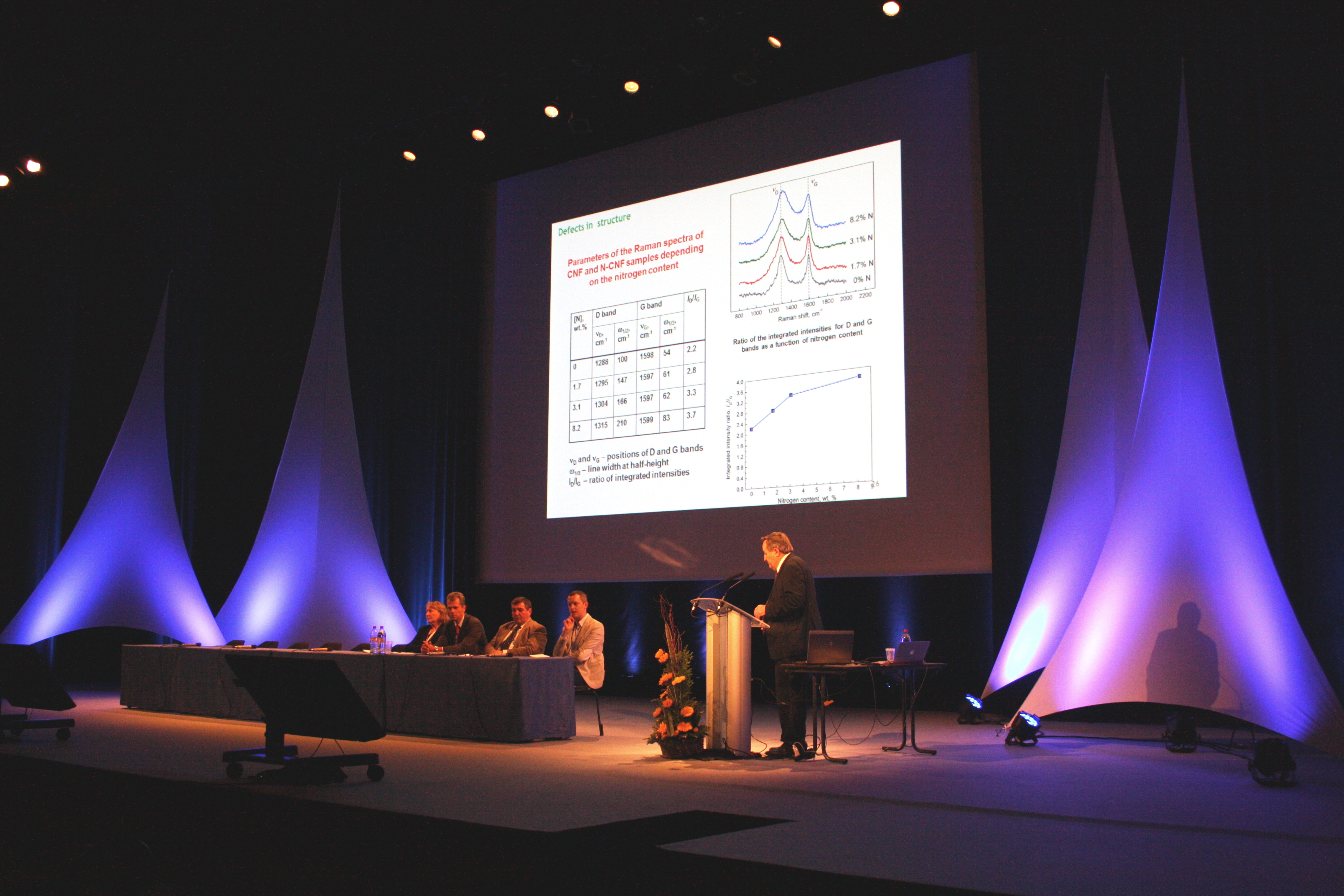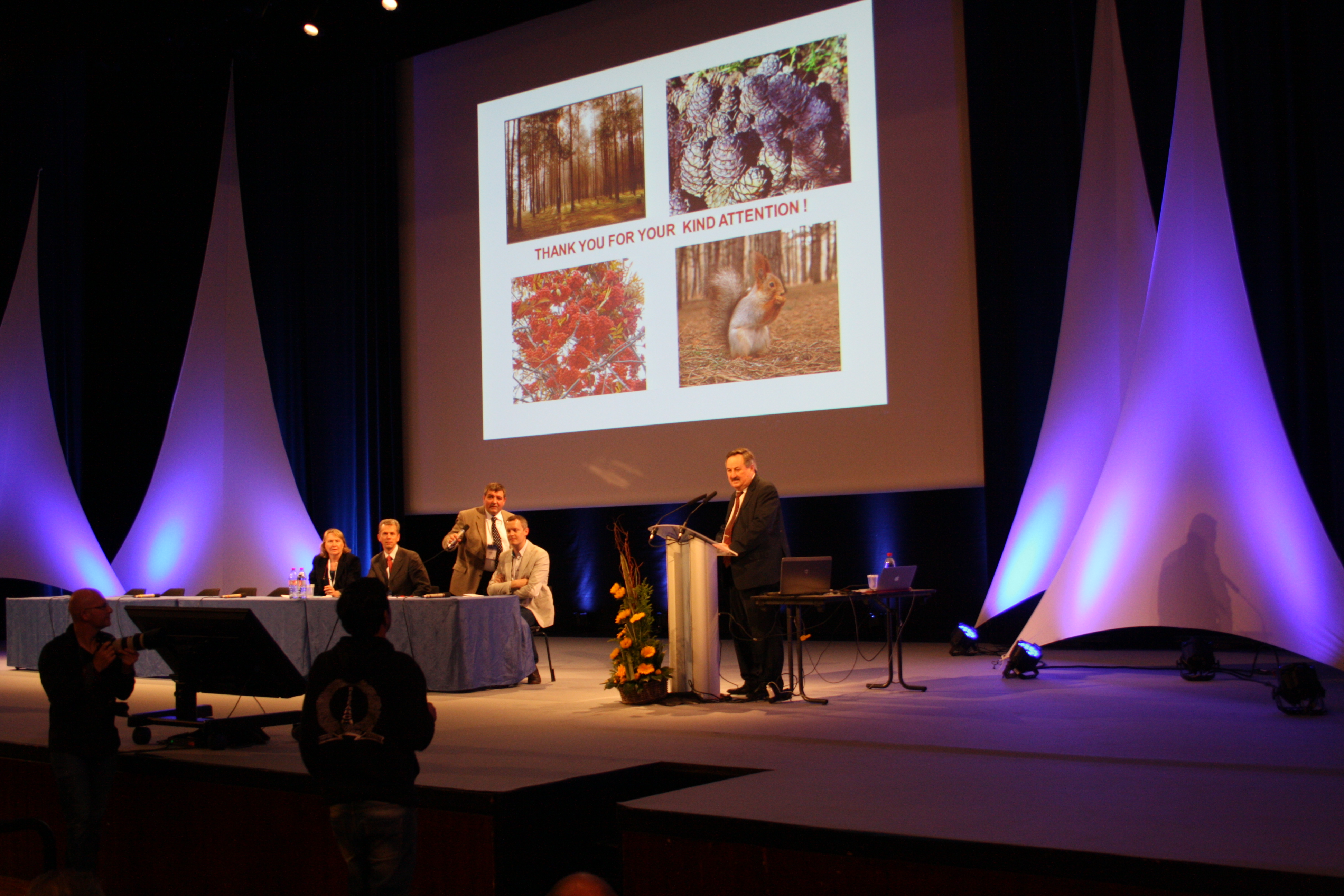Ежегодная Международная конференция «The 2015 Spring Conference of the European Materials Research Society (E-MRS, http://www.emrs-strasbourg.com/ ) прошла в городе Лилль, во Франции, в выставочном центре «Гран Пале» с 10 по 15 мая 2015 года.
Конференция посвящена, как фундаментальным аспектам синтеза и исследования свойств наноматериалов (углеродные наноматериалы и нанотрубки, графен, нановолокна, 3D мезо- и микропористые угли для катализа), так и прикладным проблемам их использования (электро- и фотокатализ, топливные элементы, хранение энергии и др.) в механизмах и устройствах энергетики, а также в технологиях для информатизации и связи.
Особое внимание на Конференции было уделено областям, связанным с разработкой материалов для возобновляемых источников энергии, для защиты окружающей среды, оптики и оптоэлектроники, биотехнологий. Большое количество докладов участников связано с органическими и био-материалами, многофункциональными оксидами для применения в электронике; их синтезом и исследованию их свойств.
В работе Конференции приняли участие около 3000 специалистов в области материаловедения из 50 стран, представившие 3748 докладов.
Организаторы Конференции – Европейское Общество Материаловедения «European Materials Research Society».
На официальном открытии Конференции выступил Президент EMRS Томас Липерт (Thomas Lippert E-MRS President). После приветствия состоялась пленарная сессия в которой были представлены 3 пленарных доклада авторитетных ученых с мировым именем. Первый пленарный доклад представил член-корр. РАН директор ИУХМ СО РАН Исмагилов З.Р. на тему: «Nitrogen-doped carbon nanomaterials: to the mechanism of growth, electrical conductivity and application in catalysis».

E-MRS 2015 PLENARY SESSION
Wednesday, May 13 (16:00 - 19:00)
Room VAUBAN (level 3)
 | 16:00 - 16:15
Welcome address Thomas Lippert
E-MRS President |
 | 16:15 - 16:55
Nitrogen-doped carbon nanomaterials: to the mechanism of growth, electrical conductivity and application in catalysis Z. R. Ismagilov (1)(2) and O. Yu. Podyacheva (2)
(1) Institute of Coal Chemistry and Material Science, Kemerovo 650000, Russia
(2) Boreskov Insitute of Catalysis, Novosibirsk 630090, Russia |
Synthesis of graphite-like carbon nanomaterials (CNMs) is a rapidly growing field of nanotechnology; by now, a large body of knowledge has been accumulated on the subject. In recent years, great efforts were made to find ways to precise control of electrophysical and adsorption properties of CNMs by modification of the carbon structure with heteroatoms, for example with the nitrogen atom (N-CNMs), for the deliberate synthesis of new functional materials.Doping of carbon nanomaterials with nitrogen produces changes in their electrophysical, adsorption and catalytic properties. The catalytic synthesis of nitrogen-doped carbon nanomaterials (N-CNMs) belongs to simple synthesis methods, is performed at moderate temperatures, leads to selective formation of N-CNMs, and is therefore more attractive than the physical synthesis methods.
A commonly accepted model describing the formation of undoped MWCNTs and CNFs on metal catalysts consists of three main steps: (1) decomposition of hydrocarbon molecules on the catalyst surface with the formation of adsorbed carbon atoms, (2) dissolution of the adsorbed carbon atoms followed by their diffusion within the catalyst particle or over its surface, and (3) formation of a nucleus and growth of a carbon tube or fiber outside the catalyst particle.
The mechanism of N-CNMs catalytic growth; the understanding of this mechanism is essential in the synthesis of active and stable catalysts for the production of N-CNMs. In situ XRD and ex situ XPS techniques were used to reveal the formation of surface nickel carbide, and oversaturated solid solution in the bulk of the particle. Correlations between composition of the reaction mixture, lattice parameter of solid solution and nitrogen content in N-CNFs were obtained.
The effect of nitrogen on conductivity of the nitrogen-doped carbon nanomaterials depends on: (1) type of conductivity is inherent in N-CNMs, (2) type of nitrogen species, and (3) total nitrogen content. The defectness of N-CNMs in comparison with CNMs estimated from the Raman spectra and optimal content of nitrogen for maximum conductivity is revealed.
The introduction of nitrogen atoms induces charges in N-CNMs, because electronegativities of nitrogen and carbon are different and equal to 3.04 and 2.55, respectively. Two main forms of nitrogen content in the quaternary state or pyridine-like nitrogen defines acid – base properties of surface.
The use of less expensive, environmentally benign and corrosion resistant CNMs is a promising way to replace the metal catalysts. The most interesting lines in the application of N-CNMs for catalysis: oxidation in the gas or liquid phase, dehydrogenation, and various reactions of organic synthesis.
In recent years, N-CNMs have been studied as the catalyst supports in various reactions. Owing to changes in physicochemical properties, the deposition of metal catalysts on N-CNMs should enhance their activity due to: (1) stabilization of metallic particles with a smaller size, narrowing of the particle size distribution, and increasing the metal-carbon binding energy, (2) acceleration of electron transfer in the catalytic system and activation of metallic particles because of the enhanced conductivity of N-CNMs, and (3) alteration of the acid-base properties of the support surface.
Changes in physicochemical properties of N-CNMs are accompanied by showing of their own catalytic activity. The beneficial role of nitrogen in provides new applications as the catalyst supports. The results of testing of N-CNMs in a number of catalytic reactions, in PEMFC and in supercapacitors will be presented.


В Президиуме Со - председатели Конференции
Conference Chairs: Manuel BIBES
CNRS/Thales Research and Technology
Campus de l'Ecole Polytechnique
1 Avenue A. Fresnel
F-91767 Palaiseau
France
Tel.: +33 (0) 1 69 41 58 49
Fax: +33 (0) 1 69 41 58 78
manuel.bibes@thalesgroup.com | Valentin CRACIUN
Laser Department
National Institute for Lasers, Plasma and Radiation Physics
Atomistilor 409
P.O. Box MG-36
RO-077125 Magurele, Ilfov
Romania
Tel.: +40 21 457 4563
Fax: +40 21 457 4243
valentin.craciun@inflpr.ro |
Laura MEDA
Dipart. Chimica-Fisica
Eni S.p.A. - Istituto Eni Donegani
Centro Ricerche per le Energie non Convenzionali
Via G. Fauser, 4
I-28100 - Novara (NO)
Italy
Tel.: +39 0321 447474
Fax: +39-0321 447525
laura.meda@eni.com | Marko TOPIC
Laboratory of Photovoltaics and Optoelectronics
University of Ljubljana
Faculty of Elec. Eng.
Trzaska 25
SI-1000 Ljubljana
Slovenia
Tel. +386 1 4768 470
Fax:+386 1 4264 630
Marko.Topic@fe.uni-lj.si |
Дальнейшая программа Конференции включала устные доклады по 32 секциям, обширную постерную сессию и большую выставку производителей оборудования, книжных издателей и различных сервисных подразделений, а также ряд рабочих семинаров. Направления работы секций:
MATERIALS FOR ENERGY AND ENVIRONMENT
1. A Materials, mechanism and devices in nano energy
2. B Materials for applications in water treatment and water splitting
3. C Advanced inorganic materials and structures for photovoltaics
4. D Earth abundant and emerging solar energy conversion materials
5. E Materials design and processing concepts for efficient and stable organic, hybrid, perovskite and dye solar cells
6. F Scientific basis of the nuclear fuel cycle – III
7. G Basic research on ionic-covalent materials for nuclear applications
MATERIALS FOR OPTICS AND OPTOELECTRONICS
8. H Nanoparticles in dielectric matrix for electronics and optics: from the fabrication to the devices
9. I Semiconductor nanostructures towards electronic and opto-electronic device applications – V
10. K Transport and photonics in group IV-based nanodevices
11. L Advances in the prediction, design, fabrication and characterization of 2-dimensional crystal and metamaterial nanostructures for nanophotonics
MULTIFUNCTIONAL OXIDES
12. M Multifunctional binary and complex oxides films and nanostructures for nanoelectronics and energy applications - II
13. N Synthesis, processing and characterization of nanoscale multi functional oxide films
14. O Fundamentals of oxide heterostructures
15. P Topological defects in ferroelectric or ferromagnetic materials: domain wall, vortices, skyrmions and beyond
ORGANIC AND BIO-MATERIALS
16. Q Organic semiconducting single crystals: from fundamentals to advanced devices
17. R Block-copolymer self-assembly for nanotechnology applications
18. S The processing-structure-property nexus of organic semiconductors
19. T Design, fabrication and self-assembly of anisotropic and patchy particle
20. U Materials and biosensor systems for in vitro diagnostic applications
21. V Bioinspired and biointegrated materials as frontiers nanomaterials V
22. W Functional surfaces and interfaces
23. X Nanomedicine advancing from bench-to-bedside: the role of materials
MATERIALS FOR ADVANCED ELECTRONICS
24. Y Science and technology of two-dimensional materials
25. Z Nanomaterials and processes for advanced semiconductor CMOS devices
26. AA Non-volatile memories: materials, nanostructures and integration approaches
27. BB Paper electronics: a new challenge for materials a new opportunity for devices II
ADVANCED MATERIALS SYNTHESIS, PROCESSING AND CHARACTERIZATION
28. CC Laser and plasma processing for advanced applications in material science
29. DD Current trends in optical and X-ray metrology of advanced materials for nanoscale devices IV
30. EE Protective coatings and thin films
31. FF Electrochemical processes for nanomaterials and their properties
32. GG ANIM 2: Advances and enhanced functionalities of anion-controlled new inorganic materials.
В ходе бесед с зарубежными учеными обсуждались возможности сотрудничества; предложено рассмотреть варианты двусторонних соглашений о проведении совместных работ. Ряд иностранных ученых заинтересовало приглашение принять участие в предстоящем Симпозиуме по Углехимии, который пройдет 4 - 7 октября 2015 года в г. Кемерово.
